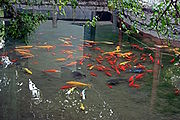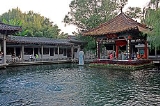
Baotu Spring
Encyclopedia
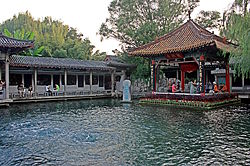
Artesian aquifer
An artesian aquifer is a confined aquifer containing groundwater under positive pressure. This causes the water level in a well to rise to a point where hydrostatic equilibrium has been reached. This type of well is called an artesian well...
karst spring
Karst spring
A karst spring is a spring that is part of a karst system. That includes the underground drainage of a much larger area, which means that karst springs often have a very large discharge...
located in the city of Jinan
Jinan
Jinan is the capital of Shandong province in Eastern China. The area of present-day Jinan has played an important role in the history of the region from the earliest beginnings of civilisation and has evolved into a major national administrative, economic, and transportation hub...
, Shandong
Shandong
' is a Province located on the eastern coast of the People's Republic of China. Shandong has played a major role in Chinese history from the beginning of Chinese civilization along the lower reaches of the Yellow River and served as a pivotal cultural and religious site for Taoism, Chinese...
Province, China
China
Chinese civilization may refer to:* China for more general discussion of the country.* Chinese culture* Greater China, the transnational community of ethnic Chinese.* History of China* Sinosphere, the area historically affected by Chinese culture...
. It is
mentioned in the Spring and Autumn Annals
Spring and Autumn Annals
The Spring and Autumn Annals is the official chronicle of the State of Lu covering the period from 722 BCE to 481 BCE. It is the earliest surviving Chinese historical text to be arranged on annalistic principles. The text is extremely concise and, if all the commentaries are excluded, about 16,000...
, one of the Five Classics of Chinese literature and was declared the "Number One Spring under the Heaven"
by the Qing Dynasty
Qing Dynasty
The Qing Dynasty was the last dynasty of China, ruling from 1644 to 1912 with a brief, abortive restoration in 1917. It was preceded by the Ming Dynasty and followed by the Republic of China....
Emperor
Emperor
An emperor is a monarch, usually the sovereign ruler of an empire or another type of imperial realm. Empress, the female equivalent, may indicate an emperor's wife or a woman who rules in her own right...
Qian Long.
Baotu Spring
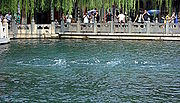
artesian springs in the downtown area of the city of Jinan. The water
of all these springs originates from an Ordovician
Ordovician
The Ordovician is a geologic period and system, the second of six of the Paleozoic Era, and covers the time between 488.3±1.7 to 443.7±1.5 million years ago . It follows the Cambrian Period and is followed by the Silurian Period...
karst aquifer under the city. As the terrain around Jinan slopes from
the south down to the north, the recharge area for the aquifer is
located in the mountainous area to the south of the city. The recharge
area of the springs covers 1,500 square kilometres, out of which 550
km2 provide direct recharge and 950 km2 indirect recharge.
its potential application to spring protection. Environ Geol (2005)
48: 551558
Altogether, the springs fed by the aquifer have a discharge of about
300,000-350,000 cubic metres per day. Since the
1970s, the springs have stopped flowing several times because too much
water has been taken out from the aquifer for human consumption (more
than 270,000 m3 per day in the 1970s).
The Baotu Spring is part of a cluster of about 20 named springs. Water age
estimates suggest that its water originates from shallow circulation
.
The spring pool of the Baotu spring is fed by an underwater limestone
water through three outlets, the volume of the water coming out of the
spring can reach peak values up to 1.6 cubic metres per second
year.
Other springs in the Baotu Group
Among the other springs in the Baotu group that are also on the list of the "seventy-two famous springs" in Jinan are:- Jinxian Spring
- Huanghua Spring
- Liuxu Spring
- Woniu Spring
- Shuyu Spring
- Mapao Spring
- Wuyou Spring
- Shiwan Spring
- Zhanlu Spring
- Manjing Spring
- Dengzhou Spring
- Dukang Spring
- Wangshui Spring
History
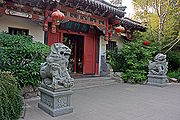
years to the times of the Shang Dynasty
Shang Dynasty
The Shang Dynasty or Yin Dynasty was, according to traditional sources, the second Chinese dynasty, after the Xia. They ruled in the northeastern regions of the area known as "China proper" in the Yellow River valley...
. The spring is
mentioned in the Spring and Autumn Annals
Spring and Autumn Annals
The Spring and Autumn Annals is the official chronicle of the State of Lu covering the period from 722 BCE to 481 BCE. It is the earliest surviving Chinese historical text to be arranged on annalistic principles. The text is extremely concise and, if all the commentaries are excluded, about 16,000...
, the official chronicle
of the ancient State of Lu and one of the Five Classics of
Chinese literature. The Baotu Spring is also described in the Suijing Zhu ("Commentary on the Waterways Classic")
compiled by the geographer Li Daoyuan
Li Daoyuan
Li Daoyuan was a Chinese geographer during thetimes of the Northern Wei Dynasty. He is known as the author ofthe Commentary to the River Classic ....
during the time of the
Northern Wei Dynasty. He writes that "spring gushes up, water
gushing like wheel".
During the time of Li Daoyuan, the Baotu Spring and adjacent springs formed the source of
the ancient Luo River.
The present-day name of the spring refers to the gushing up of the water. It dates back to the Song Dynasty
Song Dynasty
The Song Dynasty was a ruling dynasty in China between 960 and 1279; it succeeded the Five Dynasties and Ten Kingdoms Period, and was followed by the Yuan Dynasty. It was the first government in world history to issue banknotes or paper money, and the first Chinese government to establish a...
;
previously the spring had been known under different names such as
"Baoliu" and "Lanquan".
The area of the Baotu Spring as well as some neighboring springs in the same group are protected by a public park
. The park was created in 1956
and covers now about 10.5 hectares.
Architecture
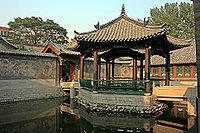
meters from east to west and 18 meters from north to south. The spring
pool is surrounded by historical structures such as the Leyuan (or Luoyuan) Hall
(Song Dynasty
Song Dynasty
The Song Dynasty was a ruling dynasty in China between 960 and 1279; it succeeded the Five Dynasties and Ten Kingdoms Period, and was followed by the Yuan Dynasty. It was the first government in world history to issue banknotes or paper money, and the first Chinese government to establish a...
, to the north of the spring), the Guanlan Pavilion
(Ming Dynasty
Ming Dynasty
The Ming Dynasty, also Empire of the Great Ming, was the ruling dynasty of China from 1368 to 1644, following the collapse of the Mongol-led Yuan Dynasty. The Ming, "one of the greatest eras of orderly government and social stability in human history", was the last dynasty in China ruled by ethnic...
, west of the spring), and the Laihe Bridge (built during the Wanli
Wanli Emperor
The Wanli Emperor was emperor of China between 1572 and 1620. His era name means "Ten thousand calendars". Born Zhu Yijun, he was the Longqing Emperor's third son...
era of the Ming Dynasty
Ming Dynasty
The Ming Dynasty, also Empire of the Great Ming, was the ruling dynasty of China from 1368 to 1644, following the collapse of the Mongol-led Yuan Dynasty. The Ming, "one of the greatest eras of orderly government and social stability in human history", was the last dynasty in China ruled by ethnic...
, east of the spring). Close by, on the shore of the spring's runoff stands the Wangheting Teahouse. Other noteworthy structures are the Banbi Corridor and the Waterside Chamber. The largest architectural ensemble is the 10,000 Bamboo Garden . It comprises 186 buildings arranged around 13 courtyards as well as four pavilions and five bridges. Originally built during the Yuan Dynasty
Yuan Dynasty
The Yuan Dynasty , or Great Yuan Empire was a ruling dynasty founded by the Mongol leader Kublai Khan, who ruled most of present-day China, all of modern Mongolia and its surrounding areas, lasting officially from 1271 to 1368. It is considered both as a division of the Mongol Empire and as an...
, it served as the residence of the governor of Shandong during the Ming Dynasty and as the home to a famous poet. In 1912, Zhang Hauizhi, a commander of the local army who later became governor of Shandong Province bought the garden and kept enlarging it from 1912 to 1927. Other gardens and architectural ensembles within the park are the Cang Garden (with the memorial to Wang Xuetao), the Luoyuan Garden, the Hundred Flowers Garden, and the (May 3rd Massacre
Jinan Incident
The Jinan Incident or May 3rd Tragedy , was an armed conflict between the Japanese Army allied with Northern Chinese warlords against the Kuomintang's southern army in Jinan, the capital of Shandong in 1928 during the Kuomintang's Northern Expedition.-Background:During the Northern Expedition,...
) Memorial Garden.
Culture

literature and has been written about by authors such as Zeng Gong
Zeng Gong
Zeng Gong , courtesy name Zigu , was a Chinese scholar and historian of the Song Dynasty in China. He was one of the supporters of the New Classical Prose Movement and is regarded as founder of one of the Eight Great Schools of Thought of the Tang and Song dynasties .Zeng Gong was born in Jianchang...
(Song Dynasty), Zhao Mengfu
Zhao Mengfu
Zhao Mengfu courtesy name Ziang , pseudonyms Songxue , Oubo , and Shuijing-gong Dao-ren , was a prince and descendant of the Song Dynasty, and a Chinese scholar, painter and calligrapher during the Yuan Dynasty.He was recommended by the Censor-in-chief Cheng Jufu to pay an audience...
(Yuan Dynasty
Yuan Dynasty
The Yuan Dynasty , or Great Yuan Empire was a ruling dynasty founded by the Mongol leader Kublai Khan, who ruled most of present-day China, all of modern Mongolia and its surrounding areas, lasting officially from 1271 to 1368. It is considered both as a division of the Mongol Empire and as an...
), and Pu Songling
Pu Songling
Pu Songling was a Qing Dynasty Chinese writer, best known as the author of Strange Stories from a Chinese Studio.-Biography:Pu was born into a poor landlord-merchant family from Zichuan...
(Qing Dynasty
Qing Dynasty
The Qing Dynasty was the last dynasty of China, ruling from 1644 to 1912 with a brief, abortive restoration in 1917. It was preceded by the Ming Dynasty and followed by the Republic of China....
). The spring was visited by the emperors Kang Xi and Qian Long who left inscriptions at the
site. Qian Long conferred on it the honorary title "First Spring under
the Heaven" .
The Baotu Spring public park also houses memorials to the local painters
Li Kuchan (1898–1983) and Wang Xuetao (1903–1982) as well as
to the poet Li Qingzhao
Li Qingzhao
Li Qingzhao was a Chinese writer and poet of the Song Dynasty, regarded by many as the premier female poet in the Chinese language.-Biography:She was born Li Qingzhao (Traditional Chinese: 李清照; Simplified Chinese: 李清照, pinyin: Lǐ Qīngzhào; Wade-Giles: Li Ch'ing-chao, pseudonym Yi'an Jushi (易安居士...
. The latter has a memorial hall set in a traditional
courtyard dedicated to her.
The Baotu Spring is the site of an annual lantern festival (starts on the Chinese New Year
Chinese New Year
Chinese New Year – often called Chinese Lunar New Year although it actually is lunisolar – is the most important of the traditional Chinese holidays. It is an all East and South-East-Asia celebration...
day and lasts for one month, and a chrysanthemum
Chrysanthemum
Chrysanthemums, often called mums or chrysanths, are of the genus constituting approximately 30 species of perennial flowering plants in the family Asteraceae which is native to Asia and northeastern Europe.-Etymology:...
show (since the 1970s, held from the end of October to the end of November.
A local beer brand ("Baotu Quan" beer produced by Jinan Beer Group Corporation)
is named after the spring and said to be brewed with water from the
spring.
Location
